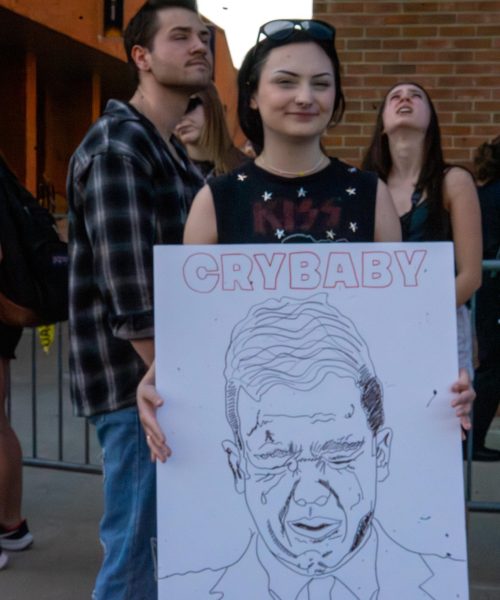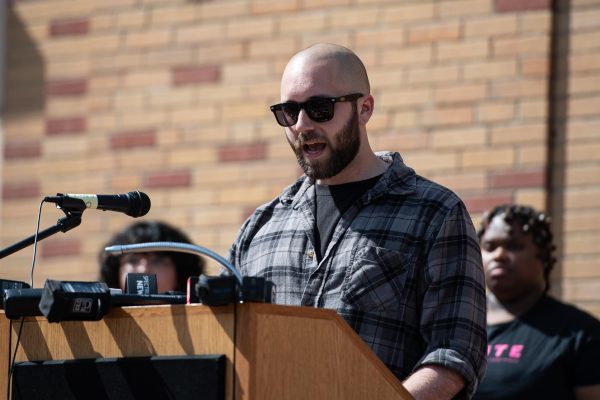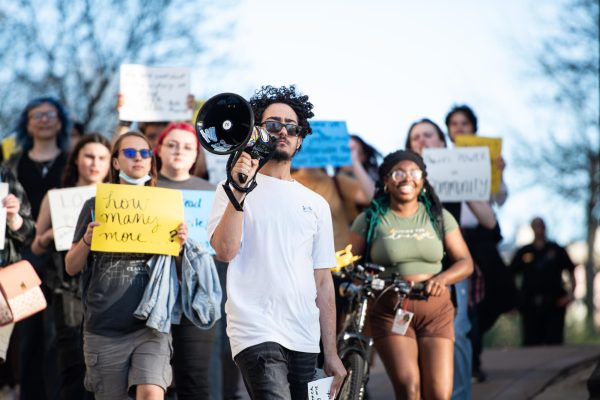Good Hair exhibit portrays beauty of black hair
Human Development major Karlee Kimble and Justice Studies major Taraya Johnson observe the photographs in the Good Hair exhibit by Moema Furtado in Oscar Ritchie Hall on April 9, 2015. The “Good” Hair exhibit celebrates the beauty and diversity of black hair.
April 12, 2015
Kent students and faculty modeled their African-American hairstyles in photographs showcased in the “‘Good’ Hair: Celebrating the Diversity and Beauty of Black Hair” exhibit at the Uumbaji Art Gallery in Oscar Ritchie Hall.
The exhibit, on display from April 9-30, demonstrates a variety of black hairdos through portrait photographs, including African-Americans with natural, braided, dreaded, curled, straightened and other hairstyles.
“I think people sometimes express themselves through their hair, and so it’s just nice to see the variety of how African-Americans choose to wear their hair,” said LaShonda Taylor, director of academic events and faculty initiatives, about why she chose to participate in the exhibition.
Twenty-four students and faculty members volunteered to be photographed for the Good Hair exhibit.
Kent State’s diversity clubs wanted to celebrate Black History Month in February, so the idea for a hair photography exhibit began, said Moema Furtado, Uumbaji Gallery curator, Good Hair exhibit photographer and international partnerships coordinator at Kent State.
“I’m just the artist who tried to convey how other people feel about their hair,” Furtado said. “In the exhibit, I have quotes for each one of the models about how they feel about their hair.”
The exhibit recognizes the problems black women and men face in a world that sometimes discourages their self-worth by categorizing beauty through hairstyles strictly based on white ideals, Furtado said.
“I think what’s important about the exhibit is it shows, in a kind way, how beautiful black hair is, how many different ways you can wear it and how flexible it is,” Furtado said. “But at the same time, the exhibit is about other stuff. It’s about culture, identity and race.”
“Black hair needs managed differently than Caucasian, Indian or Asian hair due to its texture,” said Tameka Ellington, assistant professor of fashion design and merchandising. “African types of hair do not produce oil, so African-Americans wash their hair once a week or once every other week and put oil in their hair.”
“I think it’s important for others to see the exhibit because there are still a lot of misconceptions about African-American culture,” Ellington said. “African-American people don’t know enough about their own culture, and others don’t know enough about African-American culture.”
Ellington said exhibits like the Good Hair exhibit help create the building blocks to better understand who African-American people are.
The Uumbaji Art Gallery is open 9 a.m. to 5 p.m. Monday through Friday. The Good Hair exhibit is free and open to the public.
Contact Kelsey Drumm at [email protected].
























